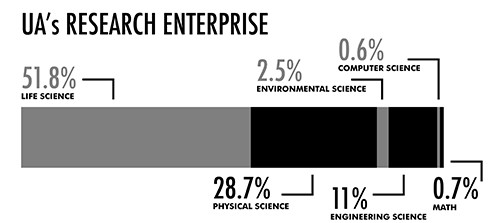Mounir Koussa started research in a UA lab after his junior year of high school. At the time, he aspired to be a doctor, so he spent the summer shadowing neurologists.
But he soon realized that his passion wasn’t medicine, it was research.
He quickly applied for a position in a Speech, Language and Hearing Sciences lab doing brain scans on recent stroke victims. But it’s his position in a developmental neurobiology lab that has been his home for four years.
“”Not only is it the willingness of the UA to let (a student) do research,”” Koussa said, “”but the willingness of the undergraduate to prove themselves in the lab and move up the scientific ladder.””
In fiscal year 2008, the UA ranked 24th among research universities nationally and 16th among public research universities in research and development spending, according to the 2010 research performance report given to the Arizona Board of Regents by the UA.
But Koussa said the state of Arizona’s economy worries him.
Research at the UA is an experience too valuable to lose. “”Without a roof over our head, we can’t do science,”” he said.
In the 2008 school year, the UA spent $565.3 million on research, a 3.4 percent increase from the previous year, according to statistics collected by the Arizona Board of Regents. In the same period, the median level of research spending at peer institutions decreased.
“”I don’t think we give ourselves enough credit as to what a good job the university does,”” said Regent Rick Myers, who works with research spending.
But the board wants the $600 million the UA currently invests in research to double to $1.2 billion by 2020, to serve the goal of boosting research initiatives at all three public universities to the $2 billion mark by the same year.
“”You can’t separate these two things (education and research),”” Myers said. “”It pervades everything we do.””
The UA topped the nation in funding for the physical sciences and remained the state’s only land-grant university and sole Association of American Universities member from Arizona.
Myers said that “”students who do research now are, yes, bringing in funding, but more than that, are working to both educate the masses of the state as well as create the knowledge base to make Arizona and its workforce and its businesses competitive on the national and world stage.””
Myers said the $2 billion goal is attainable. Leslie Tolbert, vice president for research and director of the research lab in which Koussa works, agreed that the goal is “”lofty, but not out of the question.””
“”Research is the key to the future,”” Tolbert said. “”This century, it’s not going to be OK to rely on tourism and cotton. We need to do that and much more.””
Tolbert said the UA’s strength lies in interdisciplinary research, as “”there aren’t a lot of big issues that are going to be solved by a single lone scientist sitting in a lab.””
Certain major emphases like optical science bring in large amounts of research funds. Jim Wyant, dean of the College of Optical Sciences, said 90 percent of the college’s funding comes from outside grants.
At any given time, the college has more than 200 different contracts with almost all faculty holding at least one grant.
“”(Faculty members) are hired with the understanding that they are expected to bring in funding,”” Wyant said. Around $300,000 a year is a reasonable research program amount, he said.
Wyant said the optical science combination of science and engineering makes them particularly apt to bring in funds but the college’s approach to bringing in research funding could be applied to other departments.
“”You have to have a faculty that is willing to write the proposals and go after the funding … it’s often not fun, but a faculty member has to realize that,”” Wyant said.
Tolbert said the university’s goal is to have every department double its funding. But big-dollar research projects in optical and space sciences mean doubling from $50 to $100 million, while humanities and fine arts projects would mean doubling from $5,000 to $10,000.
“”It’s not how much money,”” Tolbert said. “”We want everyone to be more engaged with research and more. The dollar amounts will be greater but that doesn’t mean that we don’t want really strong humanities research to go and flourish.””
Tolbert said because budgets on the state and national level are up in the air, it’s hard to know how much money will be able to be delineated to research.
But the interdisciplinary research methods and quality of students keeps Arizona in the running, no matter where budgets lie.
“”Every university has different areas of specialization and many universities do interdisciplinary stuff. But I’ve never been to another university that has it as a part of its basic fabric,”” Tolbert said. “”We have said for years that with budget cuts, things were going to fall apart. We keep thinking we’ll fall below an area of critical mass … but every single day across this university, brilliant work is being done. If it wasn’t you, someone you know, someone you said ‘Hi’ to today probably did something extraordinary.””
Someone like Koussa, Tolbert said.
Koussa will be attending Harvard University as a graduate student in the fall. On his interview rounds, he said many students from top-name universities had only a year or two of research experience. Koussa will graduate from the UA with five.
“”I have yet to meet anyone who has had three, four, five years of research experience and that’s not uncommon here at the UA,”” Koussa said. “”I am very much indebted to my undergraduate experience and to those people that helped me along the journey at the UA.””









